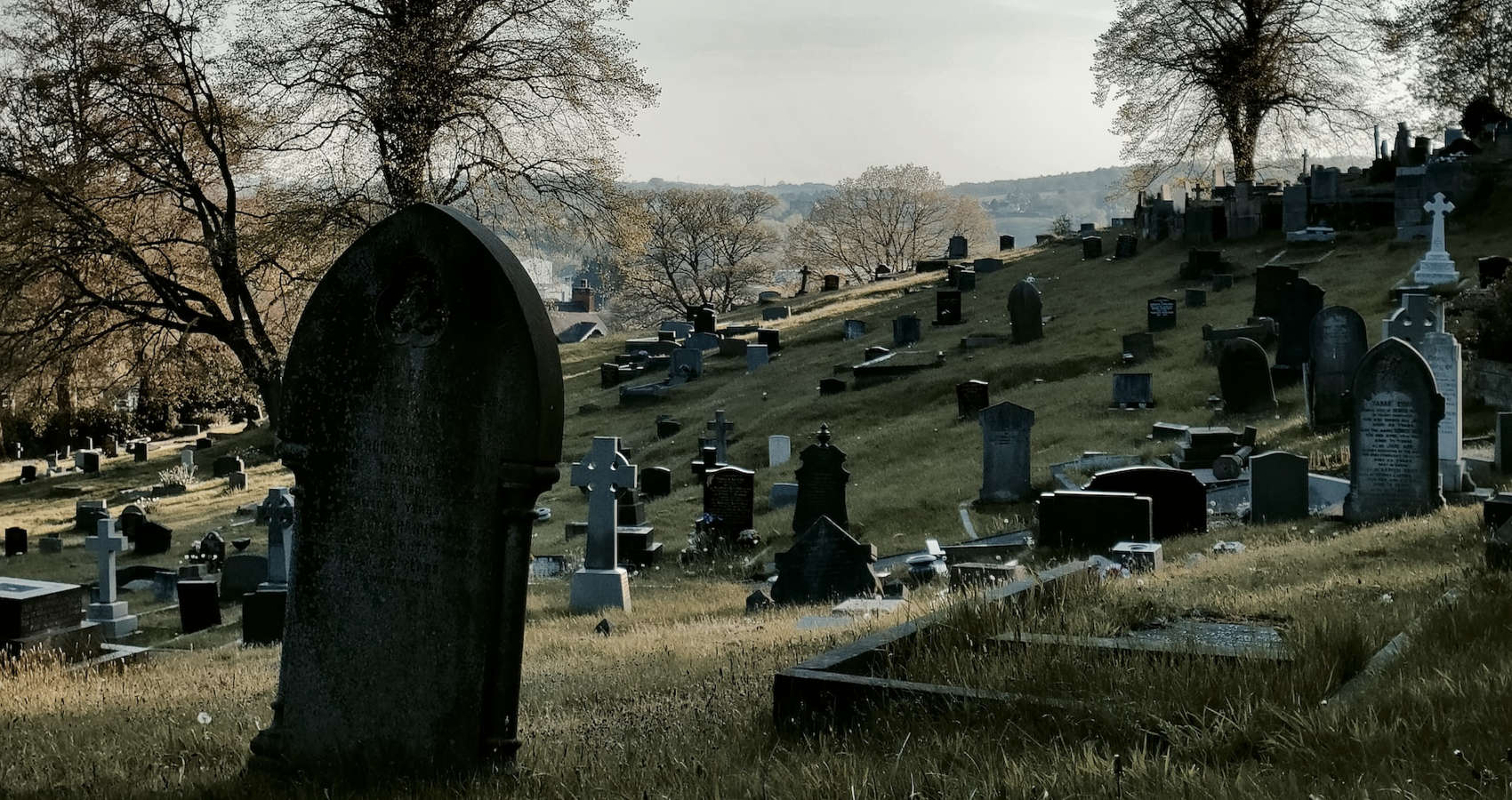Has Anybody Here Seen Kelly?
written by: Joe Cushnan
On Monday 19 July 1982 it was mild and cloudy at Lambeth Cemetery, London.
I was living in Hemel Hempstead at the time and my brother Kevin was over from Belfast for a business meeting. We met up and travelled together to Clapham as representatives of the Cushnan family for the funeral of our father, John. He died at the age of 57 from an intracranial tumour. At the funeral, all the people there knew him better than Kevin and I did. Jim Nicholson, landlord at the Rose and Crown, our father’s local, had informed my mother of her husband’s death. She wanted nothing to do with the funeral, with very good reason.
At some point in 1960, my father left his wife and seven young children in Belfast and pretty much vanished. The next we heard of him was when we were told of his death, twenty-two years later.
I was six when he left and Kevin was two. This dead man in Clapham was, to all intents and purposes, a stranger to us both.
We spent the day of the funeral surrounded by his friends, there because they knew and liked our father. But for us, there was only a bizarre emptiness. We were playing the role of mourners. I am reminded of T. S. Eliot, from Four Quartets:
Home is where one starts from. As we grow older
The world becomes stranger, the pattern more complicated
Of dead and living.
I have never felt comfortable in graveyards. The nearest one to home when I was growing up in Andersonstown, Belfast, was Milltown Cemetery. It is where most of my deceased relatives, including my mother, my eldest brother, and my grandparents, are buried. A predominantly Catholic graveyard, Milltown is situated between the top end of the Falls Road and the M1 motorway and covers nearly sixty acres. It dates back to the mid-1800s and houses (if that’s the correct term) the remains of over two hundred thousand people in around fifty thousand graves. Despite being a ‘resting place’, Milltown has had its troubling incidents in the past, the best known being when Michael Stone, a member of the Ulster Defence Association (UDA), attacked mourners at the funeral of three IRA members on 16 March 1988. He shot around the crowd randomly and threw hand grenades. Three people were killed and over sixty were wounded. Stone was arrested and eventually jailed. Northern Ireland’s ‘Troubles’ were pretty horrific over the years, but there are still some incidents that send shivers down the spine. I still associate Milltown with the chill of howling winds, miserable drizzle and, on the ghosts’ angrier days, pelting rain.
There is obvious sadness in graveyards, especially when remembering one’s own kin and friends. They would not be my first choice of location for a day out. But in my more mature years, a walk alone through the tombstones in any cemetery is both meditative and calming.
On Saturday 3 December 2016, I was walking through Lambeth Cemetery, near St. George’s Hospital, London, talking into a small voice recorder. There was no one else above ground, so I wasn’t disturbing anyone or attracting the attention of any curious onlookers; those below ground were past caring. It was a lovely cold morning, and the weather was settled and pleasant, a first for me in a graveyard.
The cemetery is a higgledy-piggledy assembly of well-maintained graves, elaborate headstones, floral arrangements, sweet, loving inscriptions, intermingled with neglected plots, their headstones leaning in precarious positions, beds of weeds, engravings worn away by time. There are around 250,000 graves, quite a few, I’m told, occupied by Victorian music hall performers such as comedian, actor and one-time clog dancer Dan Leno, and Stanley Lupino, actor, dancer and writer, and father of Hollywood star Ida. I tried to think of a cheap music hall connection to describe my father’s vanishing act. I came up with the 1908 song ‘Has Anybody Here Seen Kelly?’
David Walden, from Lambeth Cemetery office, had looked into my enquiry about my father’s grave location. The plot number is 319 in section C2, recorded in the register as burial number 21341. David had alerted me to the fact that there is no headstone.
So there I was, walking around trying to pinpoint his last resting place – his last known address. I finally decided that a patch of bare ground was the spot. I stood there for several minutes and remembered that the last time I had been there was on that Monday in July 1982, with Kevin and a reasonable crowd of mourners, at my father’s funeral. I recalled not feeling much sadness at the graveside back then, and on this December morning, thirty-four years later, I didn’t feel any different. There were no tears from his sons in 1982 and none from me in 2016 – sad but true. I even tried to force myself to cry. I stood staring at the ground wishing at least one tear would fall. I pictured his face from the few old photographs we have of him; I ran his story through my head, and thought about his selfishness and the distress he caused my mother. I considered the callousness and ruthlessness of his decision to abscond. He was uncaring, heartless, cruel, and insensitive. I felt no sorrow at all for this man; there was certainly no sense of loss but possibly a level of contempt. No matter how much I tried, my eyes stayed dry and my emotions remained in check. ‘Come not, when I am dead / To drop thy foolish tears upon my grave, / To trample round my fallen head, / And vex the unhappy dust thou wouldst not save’, wrote Tennyson in 1842.
‘I’m probably only a few feet away from his bones,’ I told the voice recorder. ‘Somewhere down there, somewhere down there.’ It was the closest I had been to him in fifty-six years.
In 1982, there wasn’t an opportunity to see the body before the coffin lid was screwed down, the usual farewell tradition back home. Perhaps if I had seen his body, I might have had different feelings towards him. Maybe witnessing his stone-cold corpse would have stirred me. Maybe the tears would have come easily.
It’s not that I’m an unemotional man. I have cried at the deaths of family members, friends – even at the passing of Elvis Presley. I can get very emotional listening to music, reading sad stories, and watching films. I’m not sure what it says about me that I can’t stir up any sign of sadness at the thought of my dead father – I will leave that to the psychologists. I have thought more than once, when re-reading drafts of this manuscript, that he did not deserve my tears. He certainly did not earn them.
As I looked at the bare gravesite, it occurred to me that even with all his new-found friends in London in the 1970s, no one cared enough about him to put some kind of a marker on his grave. I wondered, too, if any of those friends ever came back to the grave over the years to spend a few minutes with their pal. The cemetery’s maintenance team runs a lawn mower over the patch of ground in their upkeep routines, so my father’s grave is tidy enough. I wonder if they are aware that there is a body down there. For a long time, this seemingly empty patch of ground has probably been a shortcut from one marked grave to another. I considered buying a bunch of flowers to lay on the site but I decided that would be both cynical and hypocritical.
If he had a headstone, what would it say? ‘Here lies the body of John Cushnan’, or ‘Here lies the body of John Kelly.’ And the epitaph? It would be too easy to drift into sarcasm with a pithy one-liner, so I’ll let that one hang.
I said a few more things into the voice recorder – describing the surroundings and conditions. I thought I was whispering but I must have been speaking at a reasonable volume for a woman about thirty yards away called over: ‘Ah, recording memories. So important. God bless.’ She was resting on one knee by a rather colourful, neat grave. It had a solid, shiny, black headstone with gold inscriptions. It was quite grand among the various markers in section C2. She was holding a small watering can. I waved the recorder in the air and smiled. I’m not sure if I had ever smiled in a cemetery before. I hoped she wasn’t going to be a chatty type because I wanted this time on my own to contemplate. Thankfully, she waved back without a word and got on with the task of making the tidy grave even tidier. What a contrast, I thought as I looked back at my father’s rather miserable anonymous grassy patch.
So I knew that my father started life in the New Lodge area of Belfast in 1925 and I knew that he ended up in plot 319, Lambeth Cemetery, in 1982. That was something.
This research and writing task has been a little like constructing a jigsaw puzzle, getting all the straight-edged pieces into a frame, and then working on the details. It has proven to be, after Lieutenant Columbo, a series of just-one-more-thing clues leading to more clues leading to people and memories and stories – and a few facts.
I spent about half an hour at the gravesite that day, walking around it, staring at it, talking into the recorder, and jotting a few things into a notebook. I came across a note I’d made a few weeks earlier. It was a quotation from Colum McCann’s book TransAtlantic: ‘We return to the lives of those who’ve gone before us, until we come home eventually to ourselves.’
I walked towards the cemetery gates and never looked back.
NOTE FROM THE AUTHOR:
This is the first chapter of a memoir – Has Anybody Here Seen Kelly I wrote about my vanished father and heroic mother
- Dinner On the Ponderosa - February 9, 2025
- Has Anybody Here Seen Kelly? - May 30, 2023
- Wedding Daze - October 1, 2021



